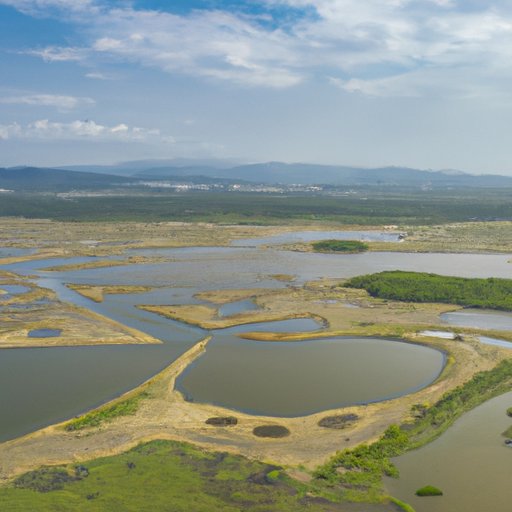Introduction
Estuaries are fascinating ecosystems that serve important ecological and economic roles. An estuary is a partially enclosed body of water where freshwater from rivers and streams mixes with saltwater from the ocean. They are unique and biologically productive areas, acting as a critical link between freshwater and saltwater environments. Estuaries support a vast array of plant and animal life and provide critical habitats for many species. Despite their importance, estuaries are under threat from human activities, such as pollution and climate change. This article explores why estuaries are important and what can be done to protect them.
The Key Role of Estuaries in Protecting the Environment and Biodiversity
Estuaries are unique ecosystems that support a diverse array of plant and animal life. They act as a critical link between freshwater and saltwater environments, and many species depend on estuaries for survival. Estuaries are essential breeding, feeding, and nursery grounds for fish and shellfish, which then go on to support larger marine populations. They also provide critical habitats for birds, mammals, and other wildlife.
Estuaries protect the environment and biodiversity by filtering pollutants, absorbing excess nutrients, and preventing erosion. They act as a buffer against storms and tidal waves, reducing the impact of flooding and coastal erosion. Moreover, estuaries are critical to addressing climate change, as they can absorb and store carbon dioxide, a greenhouse gas. Without estuaries, many species would not exist, and coastal communities would be much more vulnerable to environmental hazards.
The Economic Value of Estuaries
Estuaries also provide significant economic value, as they support a wide range of activities, such as fishing, tourism, and recreation. Fishing is one of the most significant economic activities that relies on estuaries. Estuaries provide breeding, nursery, and feeding grounds for commercial and recreational fish and shellfish. Moreover, estuaries support tourism and recreation, such as boating and birdwatching, which generate economic benefits for local communities.
Estuaries support local communities by providing food, jobs, and recreation opportunities. Many communities rely on fishing and other economic activities that depend on estuaries. According to the National Oceanic and Atmospheric Administration, commercial and recreational fishing in the United States alone generates $200 billion in sales per year and supports 1.7 million jobs.
However, these economic activities are at risk without proper conservation of estuaries. Pollution, climate change, and development can harm estuaries, which then affects the fish, shellfish, and other species that depend on them. Protecting estuaries is crucial to sustaining local economies and communities that rely on them.
The Threats to Estuaries and What Can Be Done to Protect Them
Estuaries are under threat from various human activities, including pollution, climate change, and development. Pollution, such as agricultural runoff or sewage discharges, can harm estuaries by introducing excess nutrients or harmful chemicals. Climate change, such as sea-level rise and ocean acidification, can also harm estuaries by changing the physical and chemical conditions of the water. Development, such as dredging or land reclamation, can damage or destroy estuarine habitats.
Conservation efforts can help protect estuaries. Pollution can be reduced by implementing better land management practices, such as reducing fertilizer use or improving sewage treatment. Climate change can be addressed by reducing greenhouse gas emissions, such as through using renewable energy, or by increasing the resilience of estuaries to climate change, such as through restoring wetlands. Development can be managed through careful planning or restoration of estuarine habitats.
Protecting estuaries requires collaboration among various stakeholders, including government agencies, non-governmental organizations, and local communities. Many conservation efforts rely on scientific knowledge of estuaries, their ecology, and their response to human activities.
The Science Behind Estuarine Ecology
Estuaries are complex ecosystems that result from a combination of physical and biological processes. They are influenced by tides, currents, and freshwater inflows, as well as by the interactions between organisms and their environment. Understanding the science behind estuarine ecology is essential for conserving these ecosystems.
Science has helped us understand the critical functions and services that estuaries provide, such as providing habitats and supporting fisheries. Moreover, science has informed conservation efforts by identifying threats to estuaries, such as pollution or climate change, and by developing strategies to address these threats. Scientific research has been essential for monitoring and assessing estuarine health and for developing effective management plans.
A Journey Through The Estuaries
Estuaries can be found all over the world, and each one is unique. The Chesapeake Bay in the United States, for example, is the largest estuary in the country, providing critical habitats for fish, shellfish, and other species. The Sundarbans in Bangladesh is the largest estuarine mangrove forest in the world, providing shelter for several endangered species, such as the royal Bengal tiger and the estuarine crocodile.
Estuaries can be found in many different forms, such as deltas, fjords, or lagoons. Each type has a unique physical and biological character, which influences the organisms that can live there. Moreover, each estuary has specific management needs, depending on the activities that occur in the area, such as agriculture or industry. Managing estuaries requires understanding their unique characteristics and the ecosystem services they provide.
Conclusion
Estuaries are vital ecosystems that support biodiversity and economic activities. They act as a critical link between freshwater and saltwater environments, providing habitats for many species, and supporting fishing, tourism, and recreation. However, estuaries are under threat from human activities, such as pollution and climate change. Conservation efforts and scientific research are essential for protecting these critical ecosystems. By working together, we can conserve estuaries and ensure their benefits for future generations.
